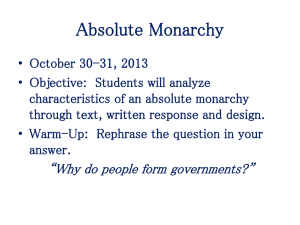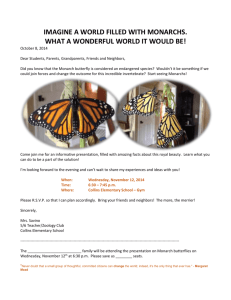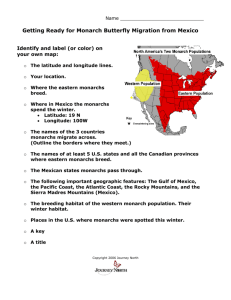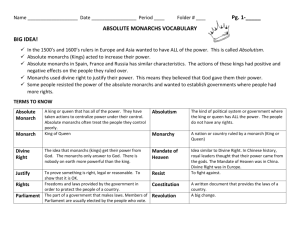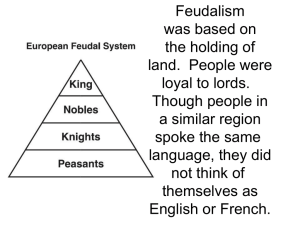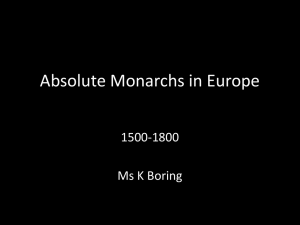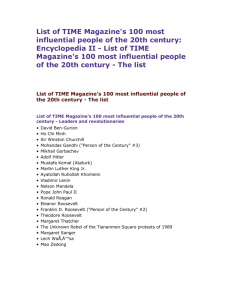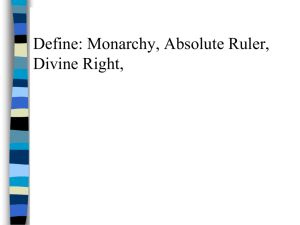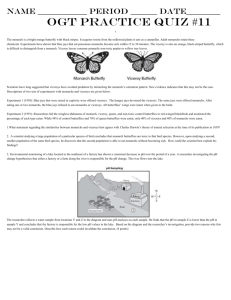Your magazine cover must
advertisement
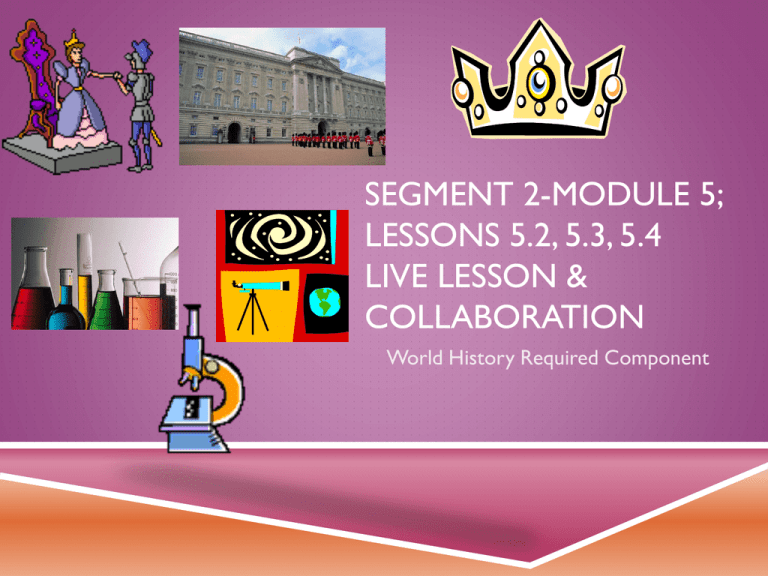
SEGMENT 2-MODULE 5; LESSONS 5.2, 5.3, 5.4 LIVE LESSON & COLLABORATION World History Required Component OBJECTIVES FOR THE DAY Be able to identify important monarchs and scientists Be able to compare and contrast absolute and constitutional monarchs Be able to summarize the Scientific Revolution and its lasting effects 5.2: CONSTITUTIONAL VS. ABSOLUTE MONARCHIES An absolute monarchy is one where the monarch has supreme or absolute power over their country. A divine right is a right given to them by God to rule. They also argued that this divine right made it so they only had to answer to the authority of God. Strong monarchs could gain new territory, strengthen armies and improve economy As time went on citizens wanted church and rulers to have less power so this resulted in constitutional monarchs A constitutional monarchy is sometimes called a democratic monarchy. The monarch is not the head of state when it comes to government power. FAMOUS ABSOLUTE MONARCHS Monarchs Ivan the Terrible Peter the Great Catherine the Great Charles V Phillip II Henry IV Louis XIV Louis XVI Maria Theresa Joseph II Known for: QUICK RECAP Phillip II Peter the Great Louis XIV Catherine the Great Maria Theresa Joseph II Queen Elizabeth, Prince William and Princess Kate 5.2 ACTIVITY DIRECTIONS You will be choosing the most influential monarch that reigned between the 16th and 18th centuries.You will then create a magazine cover and write a feature article about him or her. Step 1: Choose a Monarch from the list in the lesson Step 2: Design your Magazine Cover Now you are ready to design your magazine cover. Use the template in the lesson to design your magazine cover. (will show you how everything should be arranged) Your magazine cover must: include one main title for the magazine issue that communicates the general theme or topic of the issue Ex. Absolutism Today include one image of the monarch with a one sentence caption Ex. Louis XIV- “I am as important as the Sun” include three article titles or ‘headlines' that relate to the theme of the issue Ex. King spends millions on Versailles while citizens starve DIRECTIONS CONTINUED Step 3: Write your Article Select one of the three article headlines you created in Step 2. Your article must: include the article or headline title *be at least three paragraphs in length describe his or her greatest accomplishments and greatest challenges explain how he or she rose to power explain the impact he or she had on their nation Please see the rubric before completing this activity Any Questions? 5.3: THE SCIENTIFIC REVOLUTION During middle ages focus was on religion Things in the natural world were accepted as Gods will 1600s people began questioning old beliefs and challenged the church Began using accurate observations and measurements in their work=This led to a more accurate view of the natural world, from the stars and planets to nature around them on earth. IT’S TIME TO PLAY-NAME THAT SCIENTIST! Developed a type of calculator 1.. Father of modern anatomy 4.. Sun centered universe 8.. Observed blood circulation 5.. Improved Telescope 2.. Laws of Gravity 9.. Earth centered universe 6.. Introduced scientific method 3.. Properties of fire 7.. Father of Geometry 10.. Scientists: Ptolemy,Vesalius, Harvey, Pascal, Lavoisier, Newton, Galileo, Copernicus, Descartes, Bacon 5.4: MODERN SCIENCE In the last hundred years, modern science has dramatically altered our day-to-day lives. Communications, medicine, travel, medicine, agriculture, entertainment, and mass production were all revolutionized during the 20th century. Modern Scientists: Edison, Salk, Einstein 5.4 ACTIVITY DIRECTIONS Imagine that you are preparing a time capsule of items representing scientific achievements from the 20th century.The people who dig up your time capsule will be unfamiliar with the importance of these innovations because they are living in a world made possible by innovations developed well after you.Your job is to prepare an explanation of 20th century science and innovation for the time capsule. Step 1: Choose five advances in 20th century science that you think are the most important. Ex. Computer, Hair Dryer Step 2: Select pictures of objects that are symbolic of the advancements that you selected. Step 3: Rank them in order from most important to least important. Justify why you placed them in the order that you have chosen in three to four sentences. 5.4 DIRECTIONS CONTINUED Step 4: Create a digital time capsule. Create a digital time capsule explaining why your chosen advances were the most important. Be sure to explain who was responsible for these advances and how they affected 20th century life. To learn more about Web 2.0 tools and to help locate a tool, visit the Web 2.0 tools area. Your time capsule must: have one slide for each example that includes a two to three sentence explanation of why the advance was important have one image for each of the five example slides that represents the advancement of its impact have one final slide that includes a one paragraph justification of the order in which you placed your images Please see the rubric before completing this activity Any questions?
